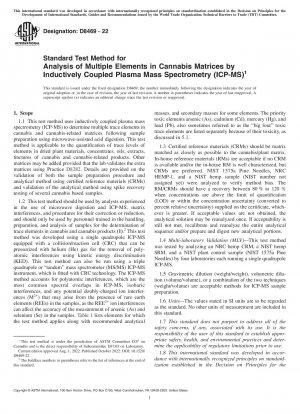ASTM D8469-22
Standard Test Method for Analysis of Multiple Elements in Cannabis Matrices by Inductively Coupled Plasma Mass Spectrometry (ICP-MS)
- Standard No.
- ASTM D8469-22
- Release Date
- 2022
- Published By
- American Society for Testing and Materials (ASTM)
- Latest
- ASTM D8469-22
- Scope
- 1.1 This test method uses inductively coupled plasma mass spectrometry (ICP-MS) to determine multiple trace elements in cannabis and cannabis-related matrices following sample preparation using microwave-assisted acid digestion. This test method is applicable to the quantification of trace levels of elements in dried plant materials, concentrates, oils, extracts, tinctures of cannabis and cannabis-related products. Other matrices may be added provided that the lab validates the extra matrices using Practice D8282. Details are provided on the validation of both the sample preparation procedure and analytical method using certified reference materials (CRMs) and validation of the analytical method using spike recovery testing of several cannabis based samples. 1.2 This test method should be used by analysts experienced in the use of microwave digestion and ICP-MS, matrix interferences, and procedures for their correction or reduction, and should only be used by personnel trained in the handling, preparation, and analysis of samples for the determination of trace elements in cannabis and cannabis products (1).2 This test method was developed using a single quadrupole ICP-MS equipped with a collision/reaction cell (CRC) that can be pressurized with helium (He) gas for the removal of polyatomic interferences using kinetic energy discrimination (KED). This test method can also be run using a triple quadrupole or “tandem” mass spectrometer (MS/MS) ICP-MS instrument, which is fitted with CRC technology. The ICP-MS method accounts for polyatomic interferences, which are the most common spectral overlaps in ICP-MS, isobaric interferences, and any potential doubly-charged ion interferences (M2+ ) that may arise from the presence of rare earth elements (REEs) in the samples, as the REE2+ ion interferences can affect the accuracy of the measurement of arsenic (As) and selenium (Se) in the samples. Table 1 lists elements for which the test method applies along with recommended analytical masses, and secondary masses for some elements. The priority toxic elements arsenic (As), cadmium (Cd), mercury (Hg), and lead (Pb), also sometimes referred to as the “big four” toxic trace elements are listed separately because of their toxicity, as discussed in 5.1. 1.3 Certified reference materials (CRMs) should be matrix matched as closely as possible to the cannabis/plant matrix. In-house reference materials (RMs) are acceptable if no CRM is available and/or the in-house RM is well characterized, but CRMs are preferred. NIST 1575a Pine Needles, NRC HEMP-1, and a NIST hemp sample (NIST number not assigned yet) were analyzed to verify method bias. The RM/CRMs should have a recovery between 80 % to 120 % when concentrations are above the limit of quantification (LOD) or within the concentration uncertainty (converted to percent relative uncertainty) supplied on the certificate, whichever is greater. If acceptable values are not obtained, the analytical solution may be reanalyzed once. If acceptability is still not met, recalibrate and reanalyze the entire analytical sequence and/or prepare and digest new analytical portions. 1.4 Multi-laboratory Validation (MLV)—This test method was tested by analyzing an NRC hemp CRM, a NIST hemp SRM, and a NIST plant control sample (NIST 1575a Pine Needles) by four laboratories each running a single quadrupole ICP-MS. 1.5 Gravimetric dilution (weight/weight), volumetric dilution (volume/volume), or a combination of the two techniques (weight/volume) are acceptable methods for ICP-MS sample preparation. 1.6 Units—The values stated in SI units are to be regarded as the standard. No other units of measurement are included in this standard. 1.7 This standard does not purport to address all of the safety concerns, if any, associated with its use. It is the responsibility of the user of this standard to establish appropriate safety, health, and environmental practices and determine the applicability of regulatory limitations prior to use. 1.8 This international standard was developed in accordance with internationally recognized principles on standardization established in the Decision on Principles for the 1 This test method is under the jurisdiction of ASTM Committee D37 on Cannabis and is the direct responsibility of Subcommittee D37.03 on Laboratory. Current edition approved Aug. 1, 2022. Published October 2022. DOI: 10.1520/ D8469-22. 2 The boldface numbers in parentheses refer to the list of references at the end of this standard. Copyright © ASTM International, 100 Barr Harbor Drive, PO Box C700, West Conshohocken, PA 19428-2959. United States This international standard was developed in accordance with internationally recognized principles on standardization established in the Decision on Principles for the Development of International Standards, Guides and Recommendations issued by the World Trade Organization Technical Barriers to Trade (TBT) Committee. 1 Development of International Standards, Guides and Recommendations issued by the World Trade Organization Technical Barriers to Trade (TBT) Committee.
ASTM D8469-22 Referenced Document
- ASTM D1193 Standard Specification for Reagent Water
- ASTM D8270 Standard Terminology Relating to Cannabis*, 2023-05-15 Update
- ASTM D8282 Standard Practice for Laboratory Test Method Validation and Method Development
- ASTM E177 Standard Practice for Use of the Terms Precision and Bias in ASTM Test Methods
- ASTM E691 Standard Practice for Conducting an Interlaboratory Study to Determine the Precision of a Test Method
ASTM D8469-22 history
- 2022 ASTM D8469-22 Standard Test Method for Analysis of Multiple Elements in Cannabis Matrices by Inductively Coupled Plasma Mass Spectrometry (ICP-MS)
